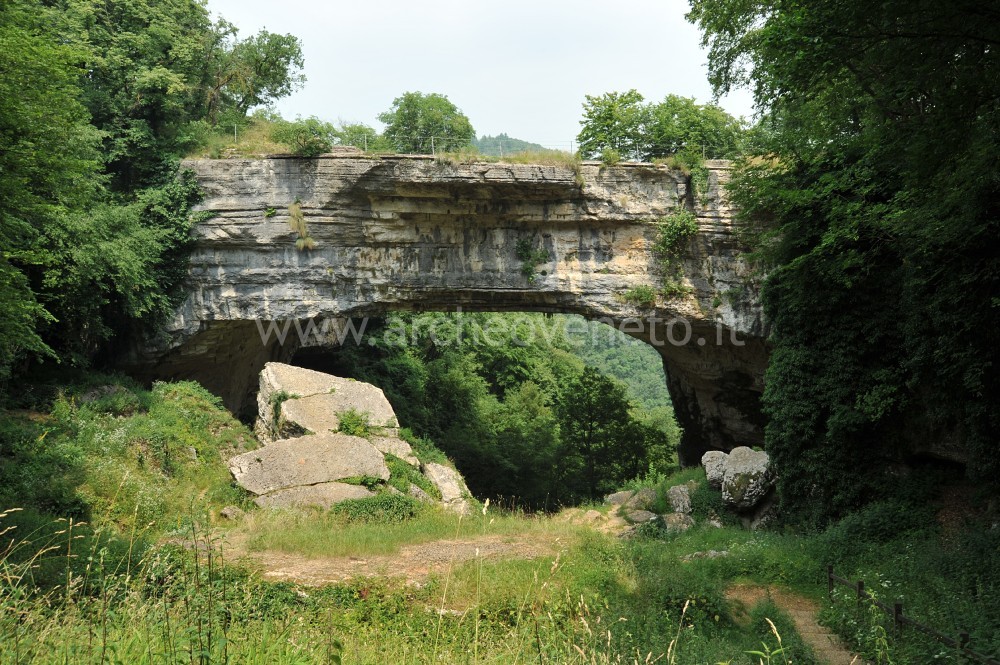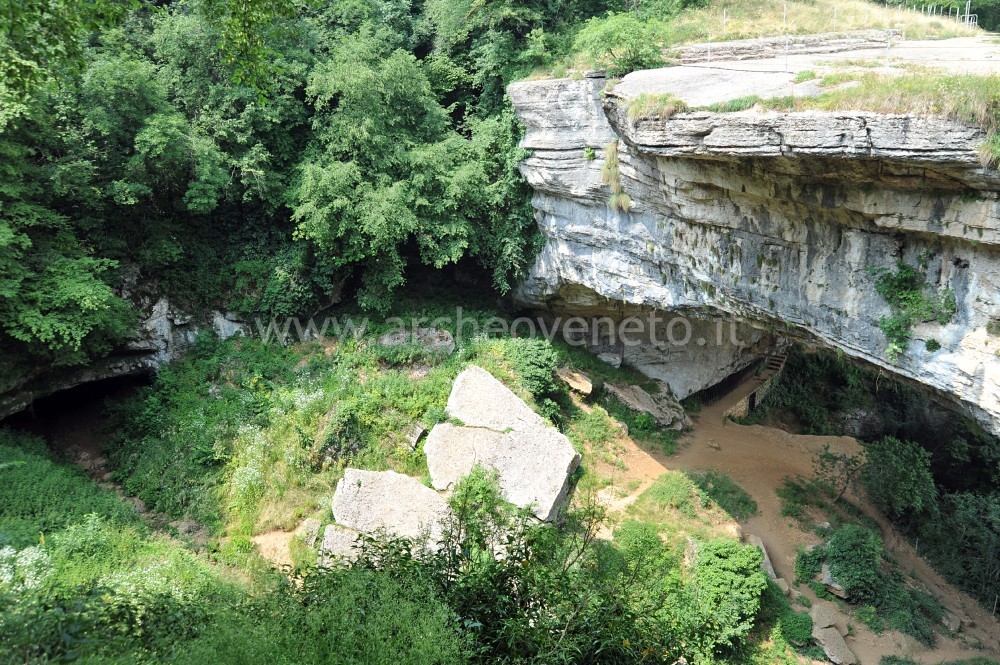|
|
File
Prehistoric caves at "Ponte di Veja" – Sant’Anna d’Alfaedo
|
| Locality Ponte di Veja – 37020 Sant’Anna d’Alfaedo (VR)
|
  |
|
Summary

The so-called bridge "Ponte di Veja" in a majestic natural monument made by the entrance architrave of a karstic cave which probably between 120.000 and 80.000 years ago. Below the fallen rocks the archaeologists have found several remains from Medium and Upper Palaeolithic. Besides, the tradition claims that the "Ponte di Veja" inspired two famous Italian artists: Dante Alighieri, who referred to it for the description of the "Malebolge" in the "Divina Commedia", and Andrea Mantegna, who portrayed it in several paintings.
History of research
The bridge is the remain of a karstic cave which collapsed around 120.000 – 80.000 years ago because of water erosion (the dating is suggested by the analyses of the pollens that were found under the collapsed rocks). A third hypothesis suggests that the bridge was originated by the earthquake in 1223. On the sides and at the basis of the bridge there are some caves that were occupied during prehistoric times and which have been under investigation from 1947. In recent times the researches have been conducted by the Museum of Natural History in Verona and by the Civic Museum in Sant’Anna di Alfaedo. The tradition claims that the "Ponte di Veja" inspired two famous Italian artists: Dante Alighieri, who referred to it for the description of the "Malebolge" in the "Divina Commedia", and Andrea Mantegna, who portrayed it in several paintings.
Urban and geographical context
The "Ponte di Veja" is located in a little valley at the end of the municipality of "Sant’Anna d’Alfaedo", at about 602 m above sea level.
Chronology
120.000 – 80.000 years before present |

 The “Ponte di Veja” is a sandstone arch originated by the karstic collapse of a cave’s vault around 120.000 years ago (as suggested by pollens’ analyses) or about 80.000 years ago. Under the bridge, but above all in the surrounding caves (caves A, C, E) the archaeologists have recovered some remains documenting the use of this area during Lower, Middle and Upper Palaeolithic, that is between 100.000 and 10.000 years ago. Particularly, these remains consist in flint tools of Musterian, Gravettian and Late Gravettian industries. The analyses of the pollens which were recovered during the excavations allowed to draw a comprehensive understanding of the ancient environment at the “Ponte di Veja”. During the Palaeolithic, this place was a montane grassland, with animals such as marmots, ibexes, red deers, aurochs, wild boars and mooses that refer to alpine climate. The “Ponte di Veja” is a sandstone arch originated by the karstic collapse of a cave’s vault around 120.000 years ago (as suggested by pollens’ analyses) or about 80.000 years ago. Under the bridge, but above all in the surrounding caves (caves A, C, E) the archaeologists have recovered some remains documenting the use of this area during Lower, Middle and Upper Palaeolithic, that is between 100.000 and 10.000 years ago. Particularly, these remains consist in flint tools of Musterian, Gravettian and Late Gravettian industries. The analyses of the pollens which were recovered during the excavations allowed to draw a comprehensive understanding of the ancient environment at the “Ponte di Veja”. During the Palaeolithic, this place was a montane grassland, with animals such as marmots, ibexes, red deers, aurochs, wild boars and mooses that refer to alpine climate.
|
Admission: Libero
Visitability: Esterno
Ticket: No
 School access School access
Recommended tour time (minutes): 40
 Bar/Resaturant Bar/Resaturant
Restaurant "Ponte di Veja"
| Bartolomei G., Broglio A., Cattani L., Cremaschi M., Guerreschi A., Leonardi P. 1984, Paleolitico e Mesolitico, in Il Veneto nell’antichità. Preistoria e Protostoria, a cura di Aspes A., Verona, pp. 178-180. |
|

